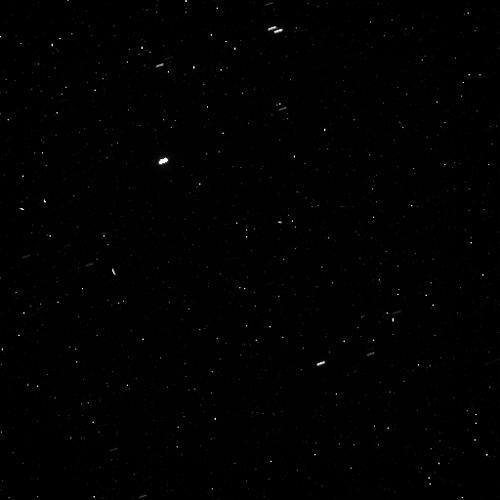Kiviuq

Kiviuq was discovered on Aug. 7, 2000 by Brett J. Gladman, John J. Kavelaars, Jean-Marc Petit, Hans Scholl, Matthew J. Holman, Brian G. Marsden, Phillip D. Nicholson, and Joseph A. Burns at the European Southern Observatory in La Silla, Chile. They discovered Ymir and Paaliaq at the same time.
Kiviuq has a mean radius of about 5 miles (8 kilometers), assuming an albedo (a measure of how reflective the surface is) of 0.06. This small, light red, irregular moon, is a dark object in a highly inclined orbit around Saturn. At a mean distance of 7.0 million miles (11.3 million kilometers) from Saturn, the moon takes about 449 Earth days to complete one orbit, while it rotates once every 21 hours and 49 minutes.
Kiviuq is one of five known members of the Inuit group of moons, which orbit Saturn at a mean distance of 7 to 11 million miles (11 to 18 million kilometers), at inclinations between 40 and 50 degrees from the plane of Saturn's equator, and with eccentricities of 0.15 to 0.48. (A moon's eccentricity is a number between 0 and 1 which describes the shape of the orbit. The closer to 0, the more circular it is; the closer to 1, the more elongated.)
The Inuit moons all have prograde orbits (they travel around Saturn in the same direction as the planet's rotation), but their deviations from circular orbits and from the plane of Saturn's equator classify them as "irregular" moons. Like Saturn's other irregular moons, they are thought to be objects that were captured by Saturn's gravity, rather than having accreted from the dusty disk that surrounded the newly formed planet, as the regular moons are thought to have done.
The similarities among the Inuit group's orbits suggest a common origin – they may be fragments of a single object that shattered in a collision. The other members of this group are Ijiraq, Paaliaq, Siarnaq, and Tarqeq.
Observations by Tommy Grav and James Bauer using telescopes on Mauna Kea, Hawaii in 2006 (before the discovery of Tarqeq) found that Kiviuq, Siarnaq and Paaliaq all are light red with similar infrared features, further supporting the idea of a common origin.
Originally called S/2000 S5, Kiviuq was named for the wandering hero of epic stories told by the Inuit people. The name was suggested by Michael Arvaarluk Kusugak, who wrote the children's books from which two other names were taken for Saturnian moons: Ijiraq and Paaliaq. He also suggested the legendary Inuit name Siarnaq, which was used for yet another of Saturn's moons.




